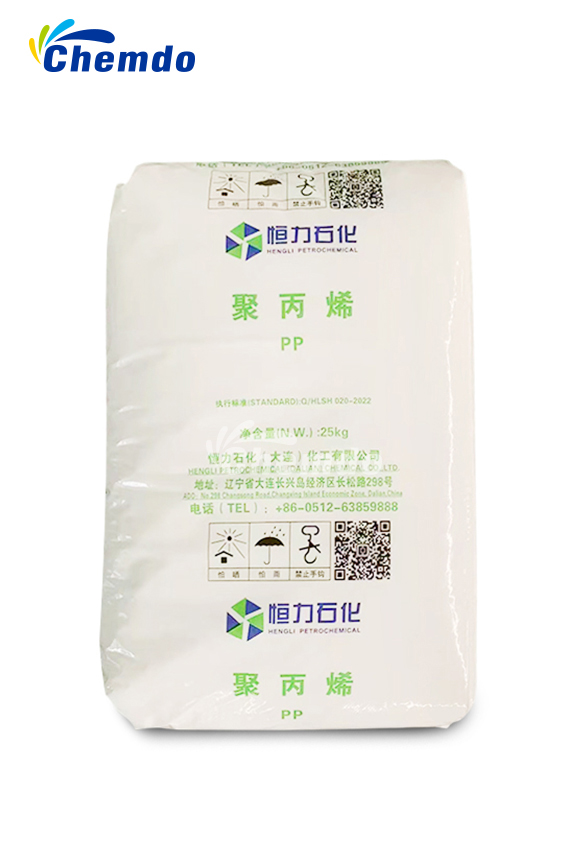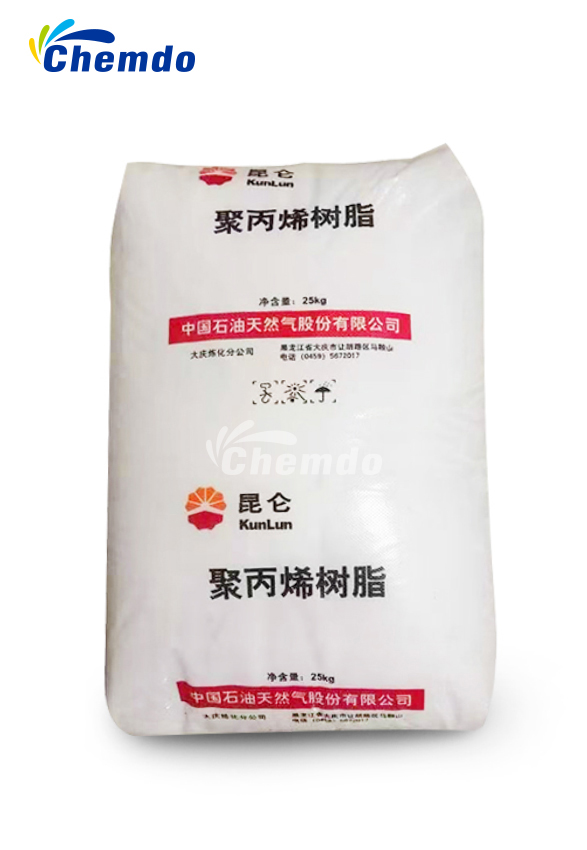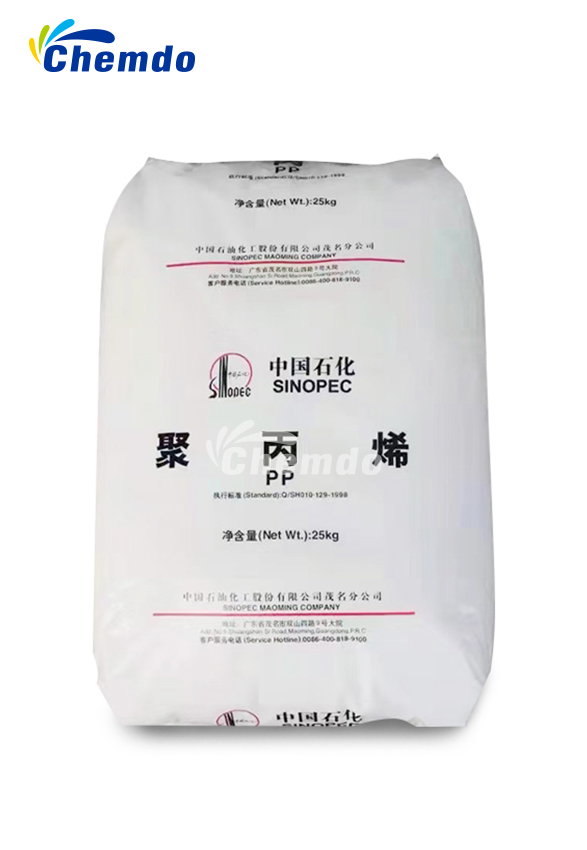Polypropylene Resin(PP-L5E89) Homo-polymer Yarn Grade, MFR(2-5)
Short Description:
Product Detail
Description
Polypropylene(PP) , a kind of non-toxic,odorless, tasteless opalescent polymer with high crystallization, the melting point among 164-170℃, the density among 0.90-0.91g/cm3, the molecular weight is about 80,000-150,000. PP is one of the lightest plastic of all varieties at present, particularly stable in water, with a water absorption rate in water for 24 hours is only 0.01%.
Application Direction
Polypropylene L5E89 adopts the Unipol gas-phase fluidized bed process of US Grace, it is widely be used to produce woven bags, fiber,applicable for textile,jumbo bags,carpet and backing etc.
Product Packaging
In net weight of 25kg bag, 16MT in one 20fcl without pallet or 26-28 MT in one 40HQ without pallet or 700kg jumbo bag, 26-28MT at most in one 40HQ without pallet.
Typical Characteristic
|
ITEM |
UNIT |
METHOD |
FC-2030 |
|
|
Melt mass flow(MFR) Standard value |
g/10min |
3.5 |
GB/T 3682.1-2018 |
|
|
Melt mass flow(MFR) Deviation value |
g/10min |
±1.0 |
GB/T 3682.1-2018 |
|
|
Dust |
%(m/m) |
≤0.05 |
GB/T 9345.1-2008 |
|
|
Tensile yield stress |
Mpa |
≥ 29.0 |
GB/T 1040.2-2006 |
|
|
Tensile fracture stress |
Mpa |
≥ 15.0 |
GB/T 1040.2-2006 |
|
|
Tensile fracture nominal stress |
% |
≥ 150 |
GB/T 1040.2-2006 |
|
|
Yellow color Index |
% |
≤ 4 |
HG/T 3862-2006 |
|
|
Haze |
% |
<6.0 |
GB/T 2410-2008 |
|
|
Fish eye 0.8 mm |
Per/1520 cm2 |
<5.0 |
GB/T 6595-1986 |
|
|
Fish eye 0.4 mm |
Per/1520 cm2 |
<30 |
GB/T 6595-1986 |
|
Product Transportation
Polypropylene resin is a non-hazardous goods.Throwing and using sharp tools like hook is strictly forbidden during transportation.Vehicles should be kept clean and dry. it must not be mixed with sand, crushed metal, coal and glass, or toxic, corrosive or flammable materials in transportation. It is strictly forbidden to be exposed to the sun or rain.
Product Storage
This product should be stored in a well ventilated, dry, clean warehouse with effective fire protection facilities. It should be kept far away from heat sources and direct sunlight. The storage is strictly prohibited in open air. A rule of storage should be followed. The storage period is not more than 12 months since the date of production.
Summary Of 8 Mainstream Processes
1. Innovene process
The main feature of the Innovene process is the use of a unique near-plug flow horizontal stirred bed reactor with internal baffles and a specially designed horizontal stirrer, the stirrer blade is angled at 45° to the stirring shaft, which can adjust the entire bed. Slow and regular stirring is performed. There are many gas and liquid phase feed points in the reaction bed from which catalyst, liquid propylene and gas are fed. The residence time distribution due to this reactor design is equivalent to 3 ideal stirred tanks The type reactors are connected in series, so the brand switching is very fast, and the transition material is very small. The process adopts the method of propylene flash evaporation to remove heat.
In addition, the process employs an air lock system, which can be shut down quickly and smoothly by stopping catalyst injection, and restarted after repressurization and catalyst injection. Due to the unique design, the process has the lowest energy consumption and operating pressure of any process , the only disadvantage is that the mass fraction of ethylene (or the proportion of rubber components) in the product is not high, and the products of ultra-high impact resistance grades cannot be obtained.
The melt flow rate (MFR) range of the homo-polymerized products of the Innovene process is very wide, which can reach 0.5~100g/10min, and the product toughness is higher than that obtained by other gas-phase polymerization processes; the MFR of the random co-polymerization products is 2~35g/10min, its The ethylene content is 7%~8%; the MFR of the impact co-polymer product is 1~35g/10min, and the ethylene mass fraction is 5%~17%.
2. Novolen Process
The Novolen process adopts two vertical reactors with double-ribbon stirring, which make the gas-solid two-phase distribution in gas-phase polymerization relatively uniform, and the heat of polymerization is withdrawn by the vaporization of liquid propylene. The homo-polymerization and The co-polymerization adopts gas phase polymerization, and its unique feature is that the homo-polymer can be produced with a co-polymerization reactor (in series with the first homo-polymerization reactor), which can increase the yield of homo-polymer by 30%. Similarly, random co-polymers can also be used. The production is carried out by connecting the reactors in series.
The Novolen process can produce all products including homo-polymers, random co-polymers, impact co-polymers, super impact co-polymers, etc. The MFR range of industrial PP homo-polymer grades is 0.2~100g/10min, random co-polymerization The highest mass fraction of ethylene in the product is 12%, and the mass fraction of ethylene in the produced impact co-polymer can reach 30% (the mass fraction of rubber is 50%). The reaction conditions for producing impact co-polymer are 60~70℃, 1.0~2.5MPa.
3. Unipol process
The Unipol process reactor is a cylindrical vertical pressure vessel with an enlarged upper diameter, which can be operated in a supercondensed state, the so-called supercondensed state gas-phase fluidized bed process (SCM).
The MFR of the homo-polymer industrially produced by the Unipol process is 0.5~100g/10min, and the mass fraction of ethylene comonomer in the random co-polymer can reach 5.5%; the random co-polymer of propylene and 1-butene has been industrialized (trade name CE -FOR), in which the mass fraction of rubber can be as high as 14%; the mass fraction of ethylene in the impact co-polymer produced by the Unipol process can reach 21% (the mass fraction of rubber is 35%).
4. Horizone Craft
The Horizone process is developed on the basis of the Innovene gas phase process technology, and there are many similarities between the two, especially the reactor design is basically the same.
The main difference between the two processes is that the two reactors of the Horizone process are vertically arranged up and down, the output of the first reactor flows directly into the air lock device by gravity, and then is fed into the second reactor with propylene pressure; while the two reactions of the Innovene process The reactors are arranged in parallel and horizontally, and the output of the first reactor is first sent to the settler at a high place, and the separated polymer powder is then fed into the air lock by gravity, and then sent to the second reactor by propylene pressure.
Compared with the two, the Horizone process is simpler in design and consumes less energy. In addition, the catalyst used in the Horizone process needs to be pretreated, which is made into a slurry with hexane, and a small amount of propylene is added for prepolymerization, otherwise the fine powder in the product will increase, the fluidity will decrease, and the operation of the co-polymerization reactor will be difficult.
The Horizone gas phase PP process can produce a full range of products. The MFR range of homo-polymer products is 0.5~300g/10min, and the ethylene mass fraction of random co-polymers is up to 6%. The MFR of impact co-polymer products is 0.5~100g /10min, the mass fraction of rubber is as high as 60%.
5. Spheripol Process
Spheripol process adopts liquid phase bulk-gas phase combined process, liquid phase loop reactor is used for prepolymerization and homo-polymerization reaction, and gas phase fluidized bed reactor is used for multiphase co-polymerization reaction. It can be divided into one ring according to production capacity and product type. There are four types of polymerization reaction forms, namely, two rings, two rings and one gas, and two rings and two gases.
The second-generation Spheripol process adopts the fourth-generation catalyst system, and the design pressure level of the prepolymerization and polymerization reactors is increased, so that the performance of the new brand is better, the performance of the old brand is improved, and it is also more conducive to the morphology, isotacticity and relative. Molecular mass control.
The product range of Spheripol process is very wide, MFR is 0.1~2 000g/10min, it can produce a full range of PP products, including PP homo-polymers, random co-polymers and terpolymers, impact co-polymers and heterogeneous impact Co-polymers, random co-polymers can reach 4.5% ethylene, impact co-polymers can reach 25%-40% ethylene, and rubber phase can reach 40%-60%.
6. Hypol Process
The Hypol process adopts the process technology of tubular liquid phase bulk-gas phase combination, uses TK-II series of high-efficiency catalysts, and currently uses the Hypol II process.
The main difference between the Hypol II process and the Spheripol process is the design of the gas phase reactor, and other units including catalyst and prepolymerization are basically the same as the Spheripol process. The Hypol II process uses a fifth-generation catalyst (RK-catalyst), which has the highest activity The activity of the fourth-generation catalyst is 2-3 times higher than that of the fourth-generation catalyst, which has high hydrogen modulation sensitivity and can produce products with a wider MFR range.
The Hypol II process uses 2 loop reactors and a gas phase fluidized bed reactor with a stirring blade to produce homopolymers and impact copolymers, the second reactor is a gas phase fluidized bed reactor with a stirring blade The reaction conditions of the loop reactor in the HypolII process are 62~75℃, 3.0~4.0MPa, and the reaction conditions for the production of impact copolymers are 70~80℃, 1.7~2.0MPa. The HypolII process can produce homopolymers, no Regular copolymer and block copolymer, the MFR range of the product is 0.3~80g/10min. The homopolymer is suitable for the production of transparent film, monofilament, tape and fiber, and the copolymer can be used for the production of household appliances, automotive and industrial parts and components. Low temperature and high impact products.
7. Spherizone Process
The Spherizone process is the latest generation of PP production technology developed by LyondellBasell on the basis of the Spheripol I process.
The multi-zone circulating reactor is divided into two reaction zones: the ascending section and the descending section. The polymer particles circulate in the two reaction zones for many times. The polymer particles in the ascending section are rapidly fluidized under the action of the circulating gas and enter the cyclone at the top of the descending section. Separator, gas-solid separation is carried out in the cyclone separator. There is a blocking area at the top of the descending section to separate the reaction gas and polymer particles. The particles move down to the bottom of the descending section and then enter the ascending section to complete a cycle. The blocking area The use of the reactor can realize the different reaction conditions of the ascending section and the descending section, and form two different reaction areas.
8. Sinopec loop pipe process
On the basis of digesting and absorbing the imported technology, Sinopec has successfully developed the loop-pipe liquid phase bulk PP process and engineering technology. Using the self-developed Z-N catalyst, the monomer propylene is coordinated and polymerized to produce homo-polymeric isotactic PP products, propylene It produces impact PP products through random co-polymerization or block co-polymerization with comonomers, forming the first-generation PP complete technology of 70,000 to 100,000 t/a.
On this basis, the second-generation loop PP complete process technology of 200,000 t/a gas-phase reactor has been developed, which can produce bimodal distribution products and high-performance impact co-polymers.
In 2014, Sinopec's "Ten-train" research project - "the third-generation environmental management PP complete technology development" jointly undertaken by Sinopec Beijing Chemical Research Institute, Sinopec Wuhan Branch and Sinopec Huajiazhuang Refining and Chemical Branch passed the The technical appraisal organized by China Petrochemical Corporation. This complete set of technology is based on the self-developed catalyst, asymmetric external electron donor technology and propylene-butylene two-component random co-polymerization technology, and developed the third-generation loop PP complete set of technology. This technology can be used to produce homo-polymerization, ethylene-propylene random co-polymerization, propylene-butylene random co-polymerization and impact-resistant co-polymer PP, etc.












